BGP7730 - Research Project: Online Health Information Seeking Behavior
VerifiedAdded on 2023/06/11
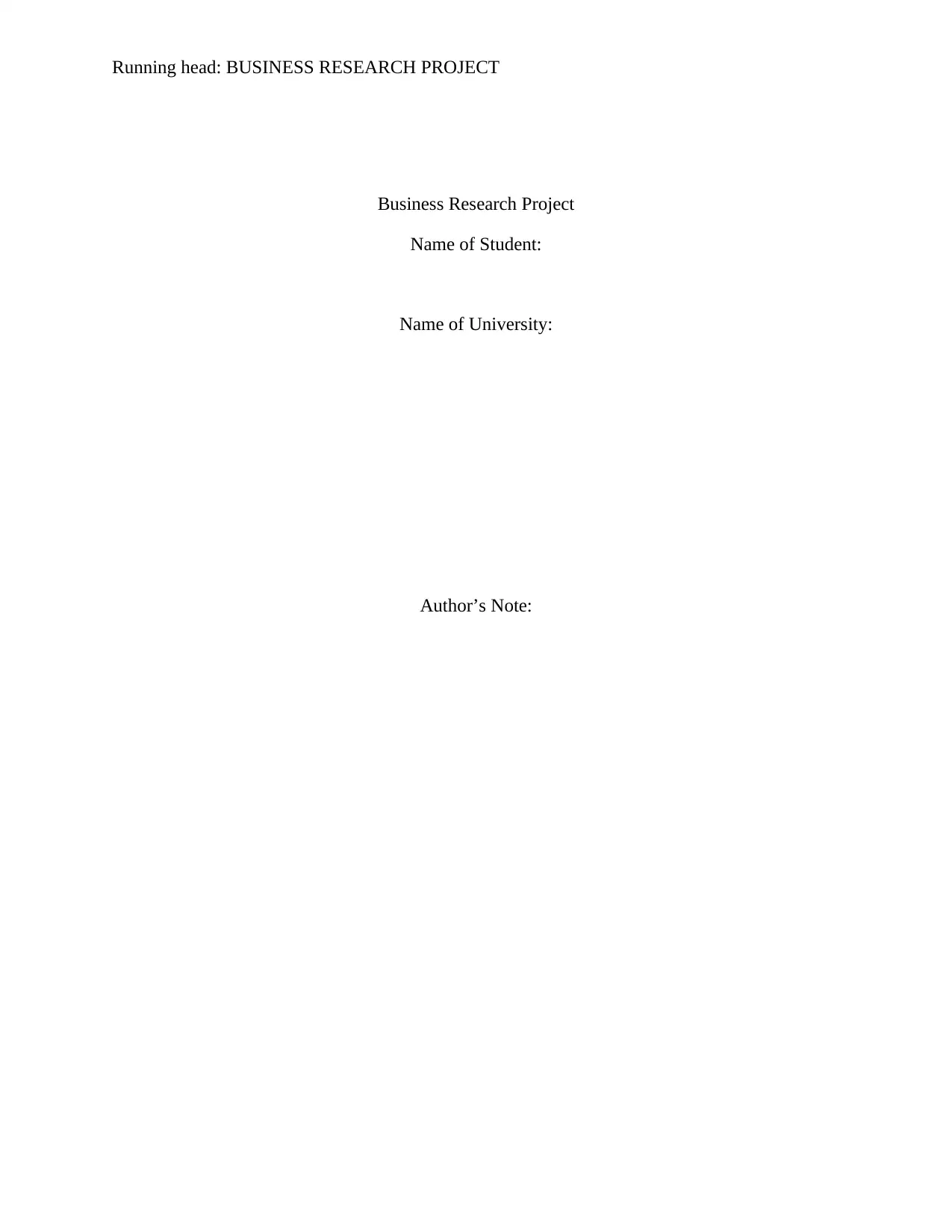
Business Research Project
Name of Student:
Name of University:
Author’s Note:
Paraphrase This Document

Executive Summary
The research has aimed to identify the difference in the gender and incidence of online health
information seeking individuals. The study has further aimed to know about the difference in the
age and frequency of online health information seeking. The latter aspect of the study has
compared the “use experience-based knowledge shared in social Internet sites”, in the social
media and support groups available online. The findings of the report have shown that thee has
been significant consideration with 94% of the users have internet access from home and
smartphone. It has been further seen that the daily use of the internet has been seen to be
determined as 94%. The response for the frequency of the use of the health information is
depicted as 88%. The total frequency of the accessing the online health information is further
seen as 42.9% opting for often option. This shows that more number of the users prefer the use
of social media sites for the accessing the health information.

Table of Contents
Introduction......................................................................................................................................3
Literature Review............................................................................................................................5
Emphasis of the Experience-Based and Expertise-Based Information for the health
information..................................................................................................................................5
Goals of Online Health Information............................................................................................6
Look for online health information for the family members:......................................................7
Methodology:...................................................................................................................................8
Introduction:................................................................................................................................8
Sample:........................................................................................................................................8
Measures:.....................................................................................................................................9
Ethical code of conduct:............................................................................................................10
Summary:...................................................................................................................................11
Findings and analysis.....................................................................................................................12
Conclusion.....................................................................................................................................20
References......................................................................................................................................22
⊘ This is a preview!⊘
Do you want full access?
Subscribe today to unlock all pages.

Trusted by 1+ million students worldwide

Introduction
Internet has been seen to be identified as a popular source of the health evidence which is
depicted to be popular source of connecting the individuals to health content, support and
experts. The internet is seen to be acting as a popular source of the number of individuals seeking
for the health information. Doctors and the health professionals have been seen to be
contributing to the online health information, however there has been a growing amount of
health information which is available in internet available from the individual patients sharing
their personal experiences. There have been several types of new digital platforms like “social
media and online support groups”(Media 2015a). These are conducive in terms of allowing a
growing number of people search for similar medical concerns. For example, there are more than
26% of the internet users who have watched or read about the other’s experiences for health and
medical issues. In addition to this, 16% of users of the social media have tried to deliberately
find the individuals with similar medical issues and 16% of the users of the internet users have
read or watched other’s experience related to medical or health issues. The social media in
various ways is seen to be beneficial to act as a crucial role for the internet users in dealing with
medical conditions such as chronic illness, high blood pressure and diabetes. There is sufficient
information to state that one in four Internet users are affected with a chronic disease (American
Hospital Association and Society for Healthcare Strategy & Market Development 2015).
The present research has identified the various types of the concepts related to two main
types of the health info, namely the suggestions related to the information formed by medical
specialists and experience-based information based on laypersons. The use of social media such
as Facebook and Twitter are used to generate the experience-based information in terms of the
Paraphrase This Document

“vast information assets that exist in in collectives and communities” (IMS Institute for
Healthcare Informatics 2014). Moreover, the various types of the experience-based information
are empowered with the ability of the internet for generating experience of the individuals,
opinion along with the pool of information. It is further depicted to identify the way the internet
users differentially trust expertise. The main form of the other aspects of the study has
empirically investigated the way empirical investigations on the way users of the Internet
differentially trust expertise- “versus experience-based information sources” (Denecke 2014).
Research Objectives
The main objectives of research are listed below as follows:
Difference in the gender and frequency of online health information seeking individuals
Difference in the age and frequency of online health information seeking
Comparing the “use experiences based knowledge shared in social Internet sites, such as
social media and online support groups”
Research Question
The formulation of the research questions is listed below as follows:
Are there any difference in the gender and frequency of online health information seeking
individuals?
Are there any difference in the gender and frequency of online health information seeking
individuals?
Is there any difference in use experience-based knowledge shared in social Internet sites,
such as social media and online support groups?

Literature Review
Emphasis of the Experience-Based and Expertise-Based Information for the health
information
In general, there has been several types of the factors in the countries such as “United
States, Korea, and Hong Kong”, for the cultural theories in order to understand the existing
variations in the perception of the individuals and seeking behaviours of the online health
information. The various types of the influences are seen to be based on the use of the info
dispensation approaches and one’s general thoughts and beliefs. It has been further depicted that
the “Nisbett and associates claim Easterners tend to possess a holistic approach, while
Westerners predominately hold analytical and logical approaches”. The use of the holistic
approach for the research is considered with the orientation of the preferences for prediction and
explaining of the events as per such relationships (Denecke and Bamidis 2015). The concept of
holism has resisted the “decontextualization, the parting of form from content, and the
dependence on actual illustrations and experiences”. On the contrary the analytical approach has
focused on the individual categories in which the object of the research is relied on the rules
using the formal logic (Media and Effects 2015).
There have been several types of the other empirical studies which has been able to show
that the Europeans and Americans are more likely to utilise the logical, analytical and rule-based
reasoning. On the other hand, the East Asians are seen to be more prone to the application of
“intuitive, experience-based, and holistic reasoning” (Louise Thomas and Woodside 2016). As
per the Norenzayan and colleagues the various types of the reasoning style of European
Americans and East Asians are depicted with the information “categorization, conceptual
structure, and deductive reasoning” (Media 2014). There are several types of the information
⊘ This is a preview!⊘
Do you want full access?
Subscribe today to unlock all pages.

Trusted by 1+ million students worldwide
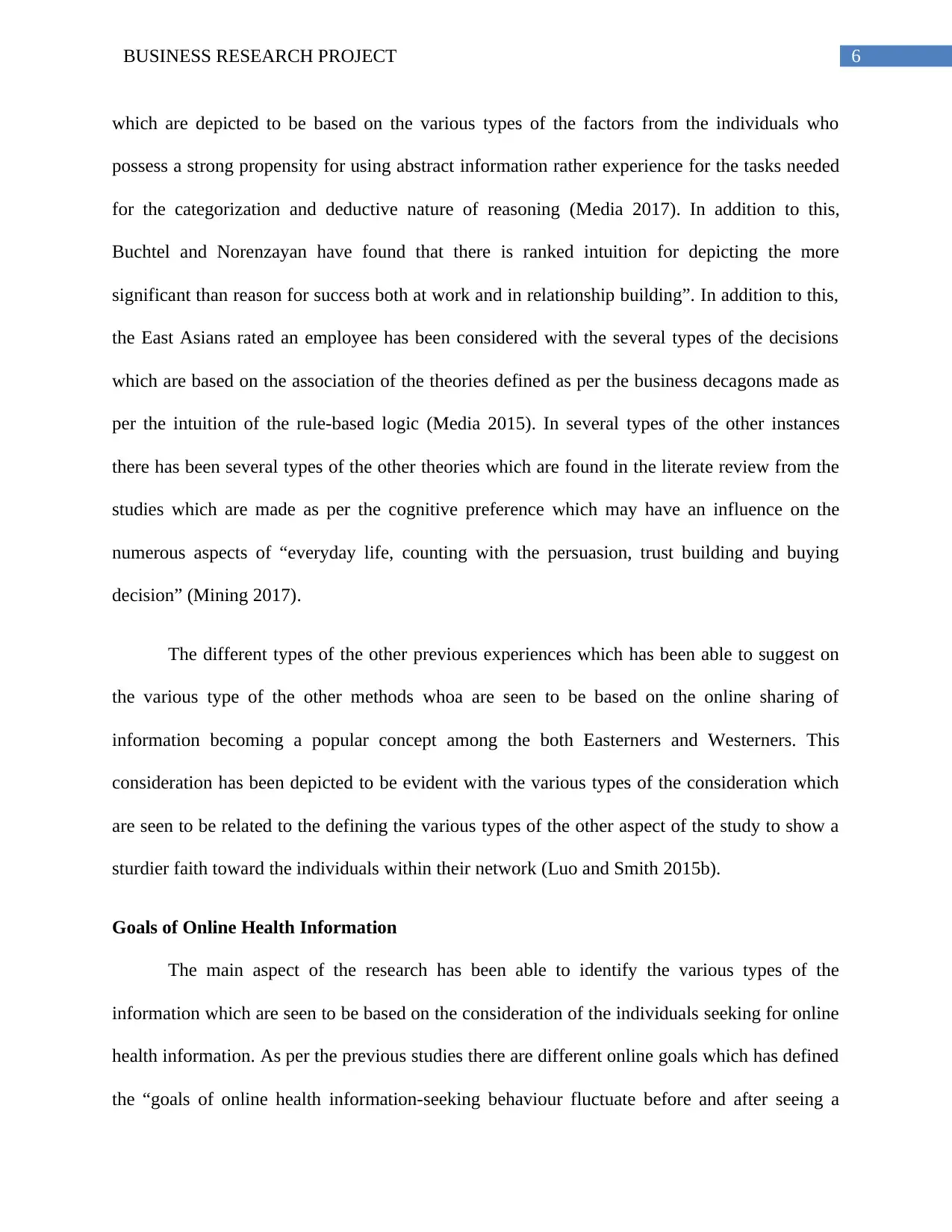
which are depicted to be based on the various types of the factors from the individuals who
possess a strong propensity for using abstract information rather experience for the tasks needed
for the categorization and deductive nature of reasoning (Media 2017). In addition to this,
Buchtel and Norenzayan have found that there is ranked intuition for depicting the more
significant than reason for success both at work and in relationship building”. In addition to this,
the East Asians rated an employee has been considered with the several types of the decisions
which are based on the association of the theories defined as per the business decagons made as
per the intuition of the rule-based logic (Media 2015). In several types of the other instances
there has been several types of the other theories which are found in the literate review from the
studies which are made as per the cognitive preference which may have an influence on the
numerous aspects of “everyday life, counting with the persuasion, trust building and buying
decision” (Mining 2017).
The different types of the other previous experiences which has been able to suggest on
the various type of the other methods whoa are seen to be based on the online sharing of
information becoming a popular concept among the both Easterners and Westerners. This
consideration has been depicted to be evident with the various types of the consideration which
are seen to be related to the defining the various types of the other aspect of the study to show a
sturdier faith toward the individuals within their network (Luo and Smith 2015b).
Goals of Online Health Information
The main aspect of the research has been able to identify the various types of the
information which are seen to be based on the consideration of the individuals seeking for online
health information. As per the previous studies there are different online goals which has defined
the “goals of online health information-seeking behaviour fluctuate before and after seeing a
Paraphrase This Document

physician”. Prior to meeting of doctor patients’ needs to go online to assess the information for
the consultation and decisive whether to visit the physician. The next important process is
depicted in terms of the analysis of the gathering of the other information which are seen with
the preparation of the information for the consultation process. After preparing for the
consultation it is further seen to be important for complementing the consultation and at the same
time validating/challenging consultation (Media 2015). As per the given nature of the
information it needs to be determined the different types of the other aspects of the research
which needs to be defined with the consideration of the information from the social media sites.
Typically there has been significant nature of the individuals who are seen to be based on
gathering of the information as per the number of people who go online with the consideration of
the several types of the goals which are considered with the functions as per the individuals
seeking for various goals for the health information which is seen to be important for the for thee
educators, healthcar4e professionals who are seen to be imparting the various types of the
information required for validating and consultation (Luo and Smith 2015). The importance of
the healthcare professionals has been evident for the gathering of the information by the website
developers which has been seen to be conducive for the congregation of the information for
better knowledge of the differences in the responses of the participants (Media 2015).
Look for online health information for the family members:
The individuals tend to find, seek and share health-related information for them and
others as well like friends and families. Nearly ½ of the online health searches are carried out for
someone else. For instance, nearly 53% of the seekers of online health information having
chronic illness disclosed their previous search of health information associated with the medical
situation of another individual (Zhang et al. 2015). Even though there is absence of adequate
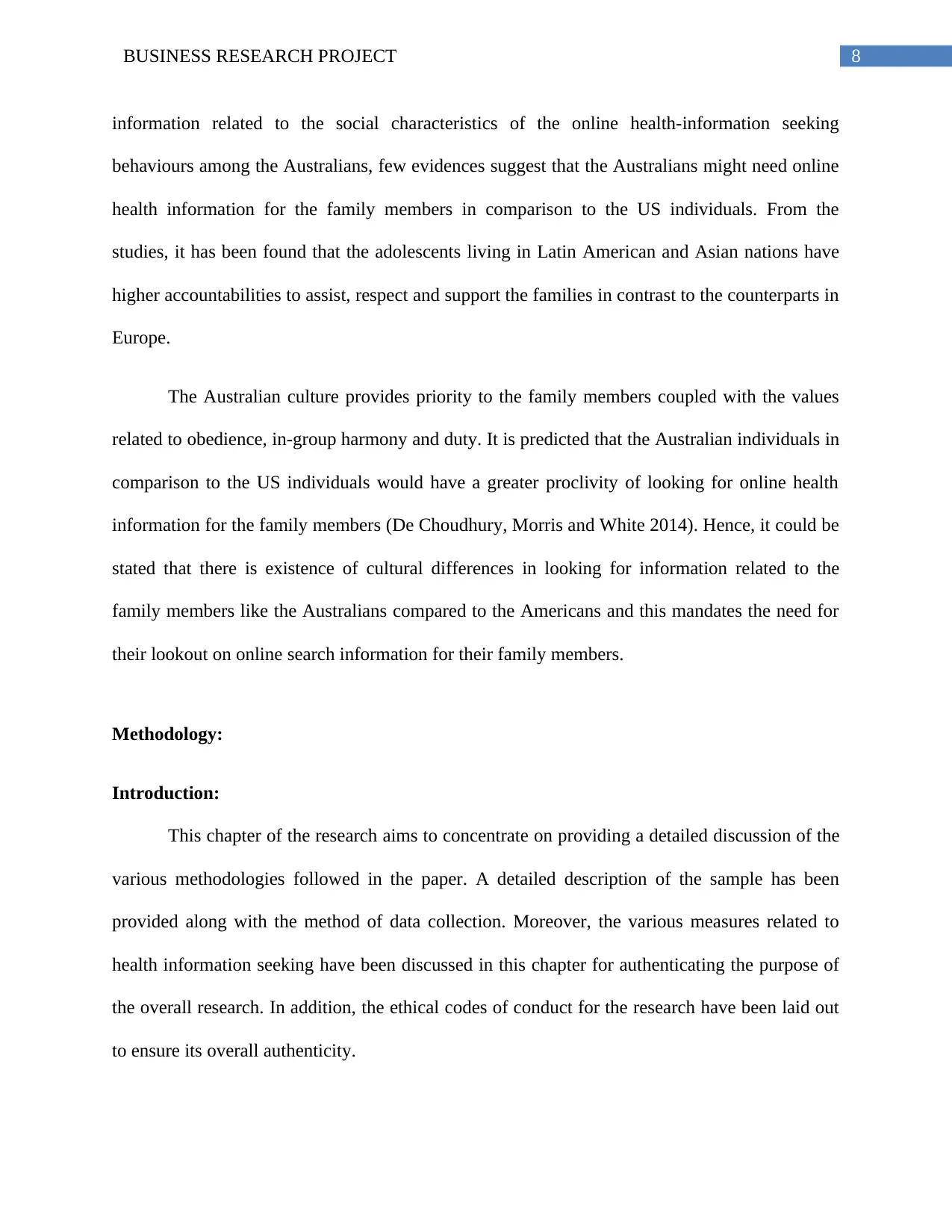
information related to the social characteristics of the online health-information seeking
behaviours among the Australians, few evidences suggest that the Australians might need online
health information for the family members in comparison to the US individuals. From the
studies, it has been found that the adolescents living in Latin American and Asian nations have
higher accountabilities to assist, respect and support the families in contrast to the counterparts in
Europe.
The Australian culture provides priority to the family members coupled with the values
related to obedience, in-group harmony and duty. It is predicted that the Australian individuals in
comparison to the US individuals would have a greater proclivity of looking for online health
information for the family members (De Choudhury, Morris and White 2014). Hence, it could be
stated that there is existence of cultural differences in looking for information related to the
family members like the Australians compared to the Americans and this mandates the need for
their lookout on online search information for their family members.
Methodology:
Introduction:
This chapter of the research aims to concentrate on providing a detailed discussion of the
various methodologies followed in the paper. A detailed description of the sample has been
provided along with the method of data collection. Moreover, the various measures related to
health information seeking have been discussed in this chapter for authenticating the purpose of
the overall research. In addition, the ethical codes of conduct for the research have been laid out
to ensure its overall authenticity.
⊘ This is a preview!⊘
Do you want full access?
Subscribe today to unlock all pages.

Trusted by 1+ million students worldwide

Sample:
The survey questionnaire for this research has been developed in English in order to
ensure the standardisation of the questions. In the recent year, the survey questionnaire has been
distributed to 50 Australian individuals residing in various cities of the nation. In addition, a
procedure of standardised recruitment and method of data collection has been ensured, in which
the involvement of the participants has been voluntary. The documents needed for IRB have
been developed and their approval has been made as well. A consent form was provided to the
surveyed individuals before the initiation of the survey process.
Measures:
Health information seeking: Trust and frequency
The frequency to use specific sources of health information like support groups, blogs
social media sites like Twitter and Facebook along with websites providing professional health
information. These websites mainly comprise of WebMD, “Centres for Disease Control and
Prevention (CDC)” has been gauged with a range from 1 to 7 each day and sources of health
information that have been modified for the cities for the nation. This enables the list to depict
the popular as well as representative sources and the media statistics and the media researchers
verify them subsequently residing in each state (Mackey and Gass 2015). The trust level in the
sources of the health information has been developed on a 5-point Likert scales varying from
strongly agree to strongly disagree.
Goals related to online health information seeking:
Paraphrase This Document
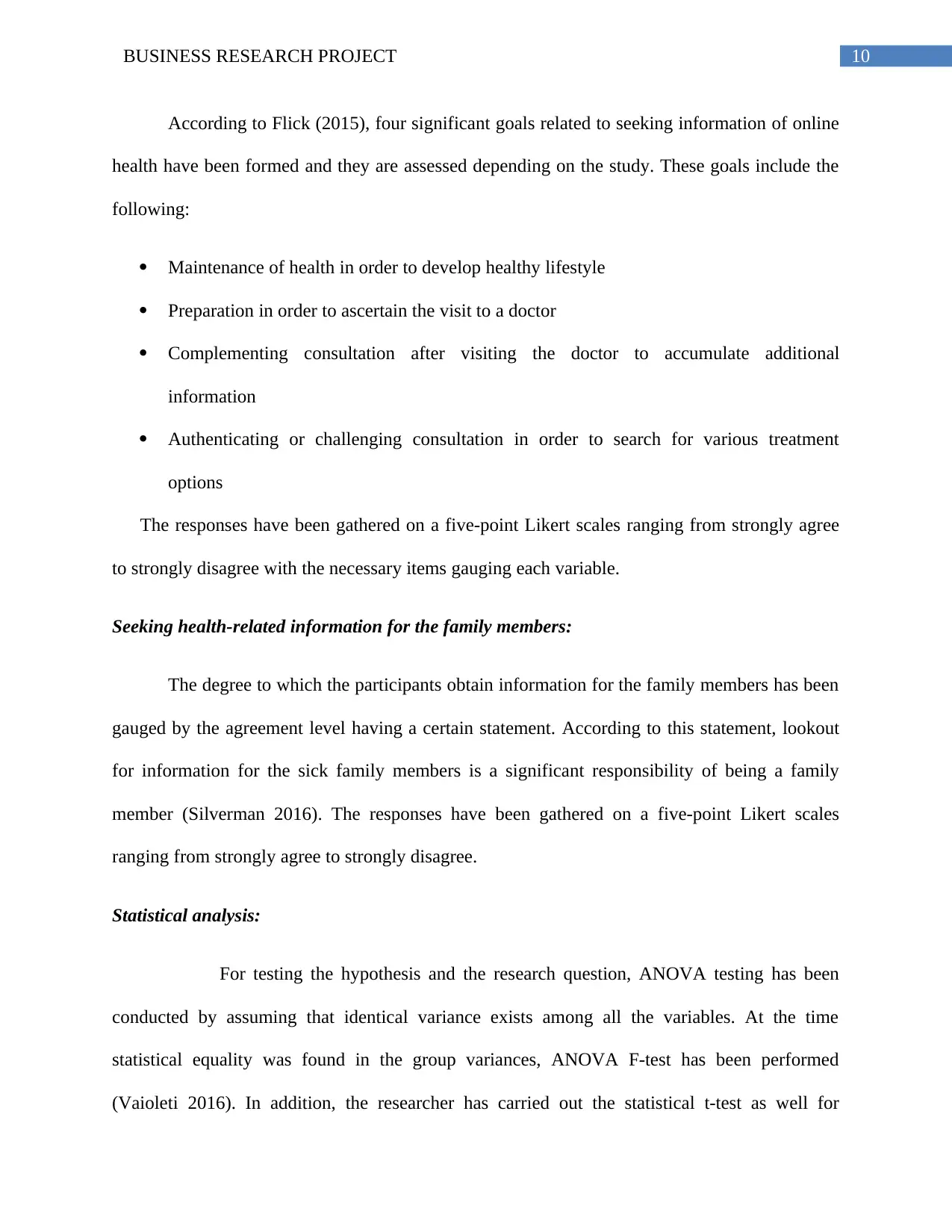
According to Flick (2015), four significant goals related to seeking information of online
health have been formed and they are assessed depending on the study. These goals include the
following:
Maintenance of health in order to develop healthy lifestyle
Preparation in order to ascertain the visit to a doctor
Complementing consultation after visiting the doctor to accumulate additional
information
Authenticating or challenging consultation in order to search for various treatment
options
The responses have been gathered on a five-point Likert scales ranging from strongly agree
to strongly disagree with the necessary items gauging each variable.
Seeking health-related information for the family members:
The degree to which the participants obtain information for the family members has been
gauged by the agreement level having a certain statement. According to this statement, lookout
for information for the sick family members is a significant responsibility of being a family
member (Silverman 2016). The responses have been gathered on a five-point Likert scales
ranging from strongly agree to strongly disagree.
Statistical analysis:
For testing the hypothesis and the research question, ANOVA testing has been
conducted by assuming that identical variance exists among all the variables. At the time
statistical equality was found in the group variances, ANOVA F-test has been performed
(Vaioleti 2016). In addition, the researcher has carried out the statistical t-test as well for
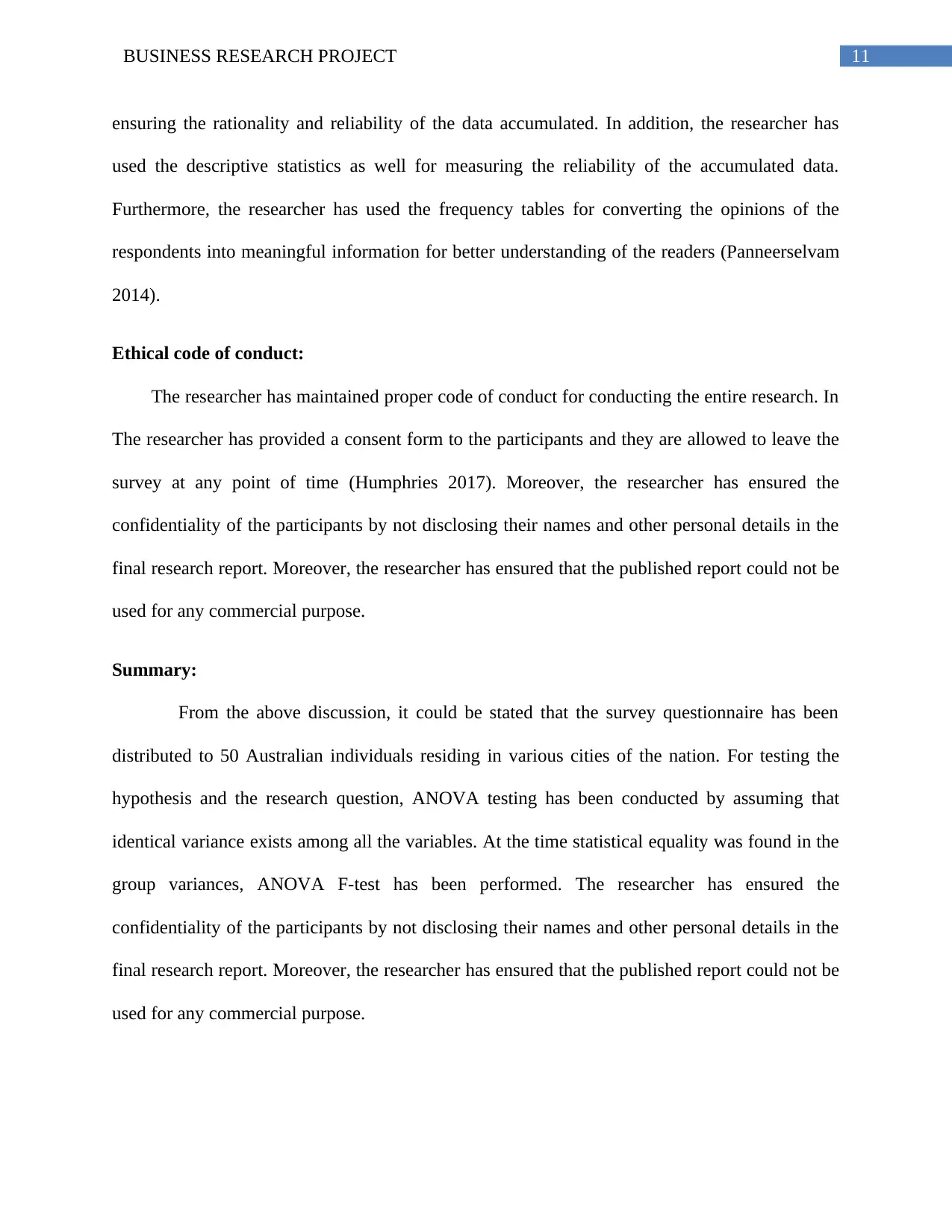
ensuring the rationality and reliability of the data accumulated. In addition, the researcher has
used the descriptive statistics as well for measuring the reliability of the accumulated data.
Furthermore, the researcher has used the frequency tables for converting the opinions of the
respondents into meaningful information for better understanding of the readers (Panneerselvam
2014).
Ethical code of conduct:
The researcher has maintained proper code of conduct for conducting the entire research. In
The researcher has provided a consent form to the participants and they are allowed to leave the
survey at any point of time (Humphries 2017). Moreover, the researcher has ensured the
confidentiality of the participants by not disclosing their names and other personal details in the
final research report. Moreover, the researcher has ensured that the published report could not be
used for any commercial purpose.
Summary:
From the above discussion, it could be stated that the survey questionnaire has been
distributed to 50 Australian individuals residing in various cities of the nation. For testing the
hypothesis and the research question, ANOVA testing has been conducted by assuming that
identical variance exists among all the variables. At the time statistical equality was found in the
group variances, ANOVA F-test has been performed. The researcher has ensured the
confidentiality of the participants by not disclosing their names and other personal details in the
final research report. Moreover, the researcher has ensured that the published report could not be
used for any commercial purpose.
⊘ This is a preview!⊘
Do you want full access?
Subscribe today to unlock all pages.

Trusted by 1+ million students worldwide

Findings and analysis
As per the various types of the findings and the analysis of the results it has been seen to
be there has been several types of the scopes of the information which has been separated into
various groups and subgroups. These groups are identified with the consideration of the
information which has been depicted with the gender, age group, internet access and daily use of
the internet. Based on the gender analysis 62% of the female participants of the social media
users searching for health information. In addition to this, 38% of the male participants of the
social media users searching for health information. This depiction clearly shows that there is a
more number of the female participants who have shown active response to the searching of the
information related to health (Monkman, Kushniruk and Borycki 2014).
The various types of the depictions of the information as per comparing the knowledge of
the users which are shared in social Internet sites, such as social media. This have been seen with
mostly positive results (L. Thomas and Woodside 2016). In general, there has been large number
of the depictions of the results which are considered with the various types of the depositions of
the results which are in favour of the depictions of the information which are favoured to be
positive for more experienced users. Hence it can be stated that more number of the experienced
users are depicted with the use of internet and social media for searching of health-related
information (Batane 2014).
The analysis as per the respondents has further shown that more than 94% of the users
have internet access from home and smartphone. It has been further seen that the daily use of the
internet has been seen to be determined as 94%. The response for the frequency of the use of the
health information is depicted as 88%. The total frequency of the accessing the online health
Paraphrase This Document

information is further seen as 42.9% opting for often. The consideration of the SNS is further
seen as 44% with often responses (Smailhodzic, Boonstra and Langley 2016). The results
interpreted as per the survey is further seen to be based on the different types of the analysis of
the information which is shown with the high amount of responses which are in favour of the
accessing of the blog information. Some of the different types of the other information is
analysed with the high amount of response for the support group access (Fox, Savage and
Vannahme 2016).
The consideration of the access of the information as per the professional help from the
health care professional has been seen to be based on the most responses in favour of often
option. In addition to this the results as per the results of the T-Test the equality of the variances
is seen to be depicted with .224. This shows that the there is a significant nature of the
relationship of gender and frequency of online health information seeking individuals (J. et al.
2017).
The results of the Anova is seen to be resulting to .621 for the mean square between the
group and 1.462 within the groups. These results are considered with the depiction of the
information which is able to state that there is considerable amount of the significance of the
difference in the age and frequency of individuals online health information seeking (Gamache-
O ’leary and Grant 2017).
Frequencies
Statistics
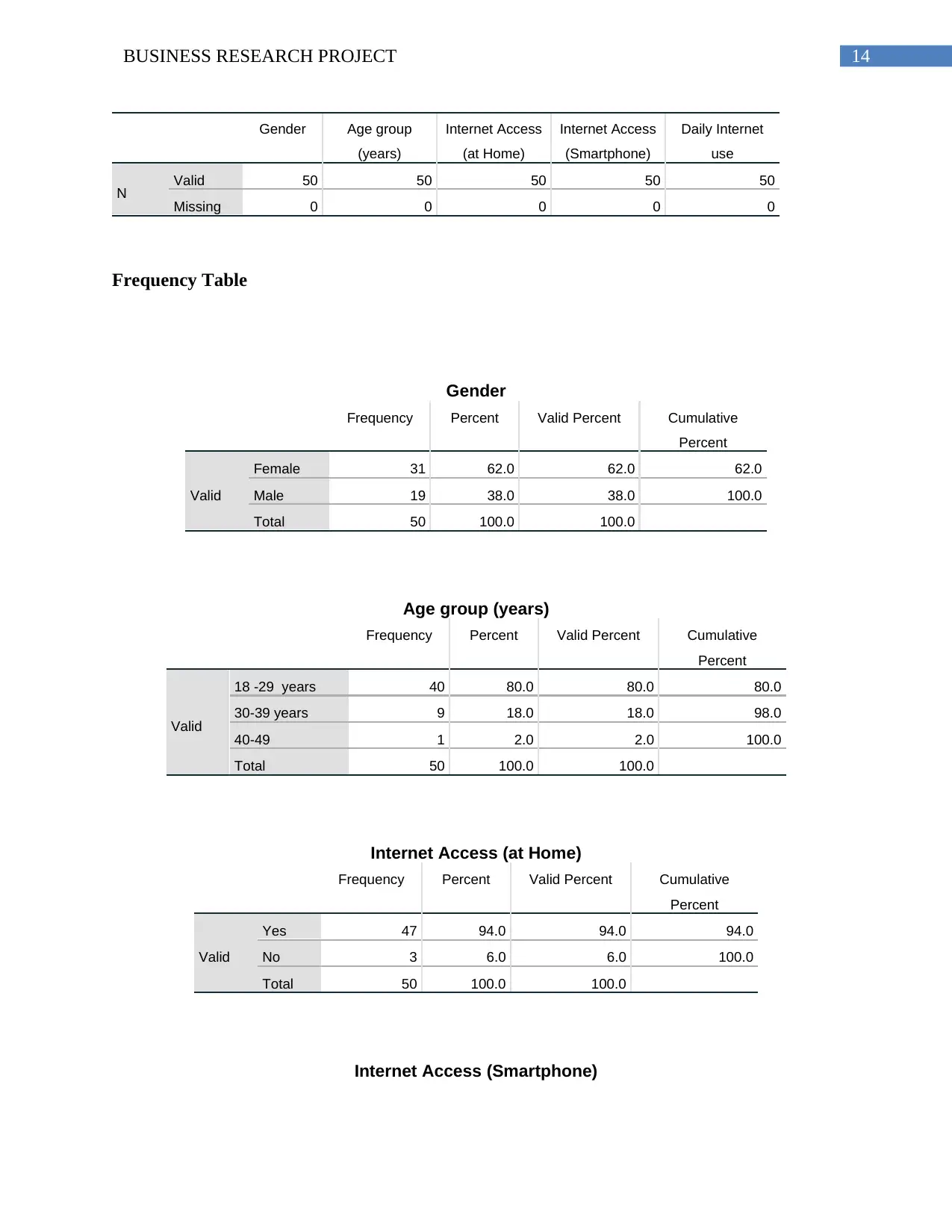
Gender Age group
(years)
Internet Access
(at Home)
Internet Access
(Smartphone)
Daily Internet
use
N Valid 50 50 50 50 50
Missing 0 0 0 0 0
Frequency Table
Gender
Frequency Percent Valid Percent Cumulative
Percent
Valid
Female 31 62.0 62.0 62.0
Male 19 38.0 38.0 100.0
Total 50 100.0 100.0
Age group (years)
Frequency Percent Valid Percent Cumulative
Percent
Valid
18 -29 years 40 80.0 80.0 80.0
30-39 years 9 18.0 18.0 98.0
40-49 1 2.0 2.0 100.0
Total 50 100.0 100.0
Internet Access (at Home)
Frequency Percent Valid Percent Cumulative
Percent
Valid
Yes 47 94.0 94.0 94.0
No 3 6.0 6.0 100.0
Total 50 100.0 100.0
Internet Access (Smartphone)
⊘ This is a preview!⊘
Do you want full access?
Subscribe today to unlock all pages.

Trusted by 1+ million students worldwide
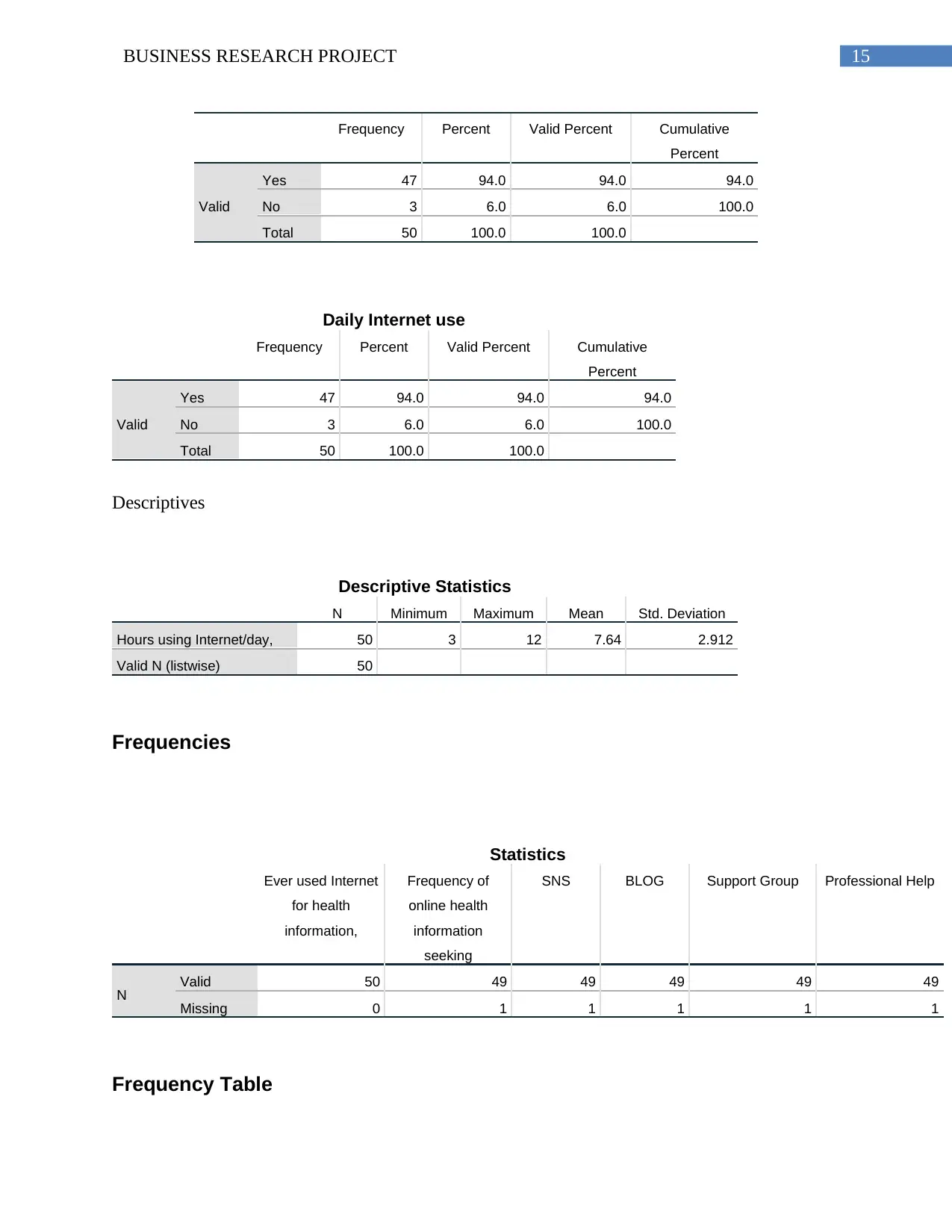
Frequency Percent Valid Percent Cumulative
Percent
Valid
Yes 47 94.0 94.0 94.0
No 3 6.0 6.0 100.0
Total 50 100.0 100.0
Daily Internet use
Frequency Percent Valid Percent Cumulative
Percent
Valid
Yes 47 94.0 94.0 94.0
No 3 6.0 6.0 100.0
Total 50 100.0 100.0
Descriptives
Descriptive Statistics
N Minimum Maximum Mean Std. Deviation
Hours using Internet/day, 50 3 12 7.64 2.912
Valid N (listwise) 50
Frequencies
Statistics
Ever used Internet
for health
information,
Frequency of
online health
information
seeking
SNS BLOG Support Group Professional Help
N Valid 50 49 49 49 49 49
Missing 0 1 1 1 1 1
Frequency Table
Paraphrase This Document
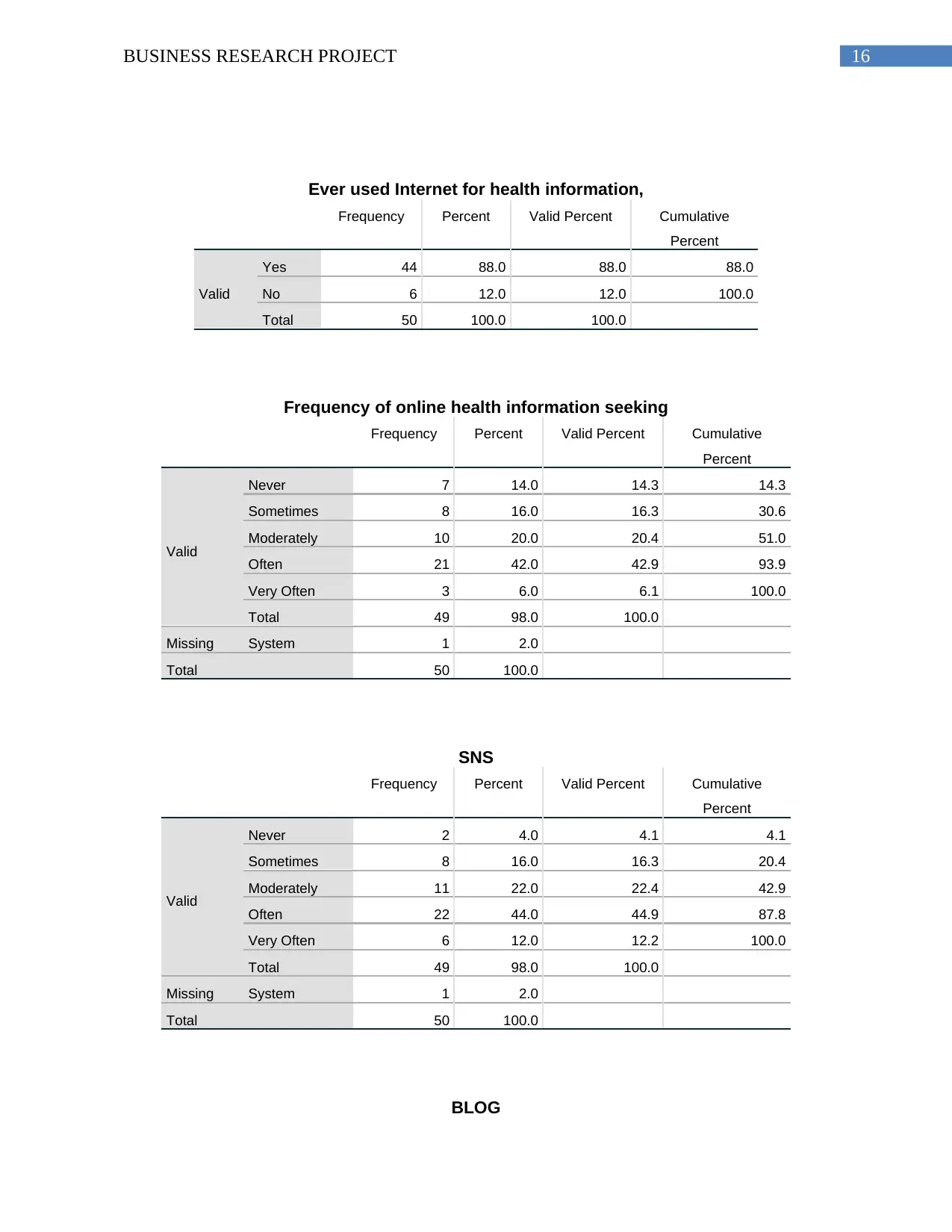
Ever used Internet for health information,
Frequency Percent Valid Percent Cumulative
Percent
Valid
Yes 44 88.0 88.0 88.0
No 6 12.0 12.0 100.0
Total 50 100.0 100.0
Frequency of online health information seeking
Frequency Percent Valid Percent Cumulative
Percent
Valid
Never 7 14.0 14.3 14.3
Sometimes 8 16.0 16.3 30.6
Moderately 10 20.0 20.4 51.0
Often 21 42.0 42.9 93.9
Very Often 3 6.0 6.1 100.0
Total 49 98.0 100.0
Missing System 1 2.0
Total 50 100.0
SNS
Frequency Percent Valid Percent Cumulative
Percent
Valid
Never 2 4.0 4.1 4.1
Sometimes 8 16.0 16.3 20.4
Moderately 11 22.0 22.4 42.9
Often 22 44.0 44.9 87.8
Very Often 6 12.0 12.2 100.0
Total 49 98.0 100.0
Missing System 1 2.0
Total 50 100.0
BLOG
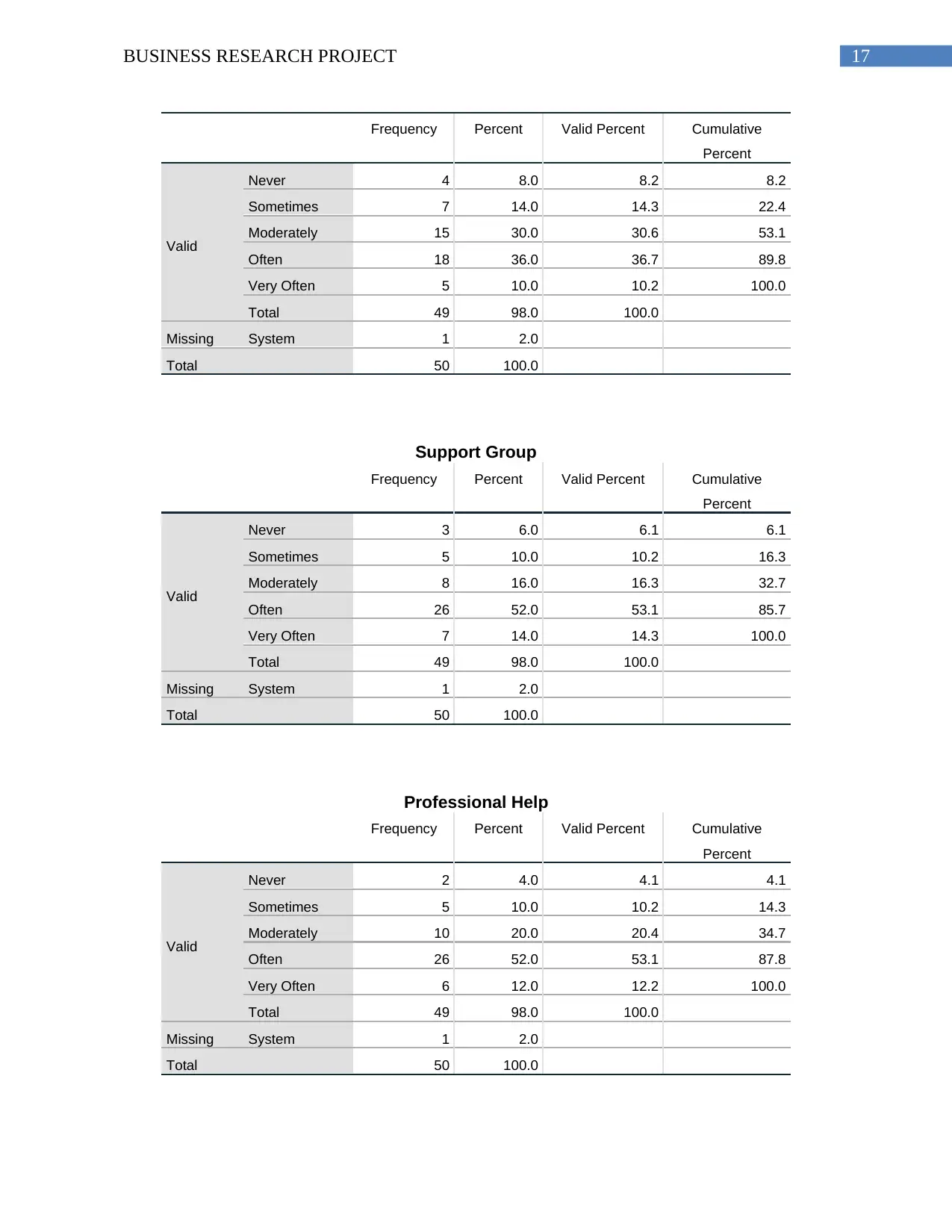
Frequency Percent Valid Percent Cumulative
Percent
Valid
Never 4 8.0 8.2 8.2
Sometimes 7 14.0 14.3 22.4
Moderately 15 30.0 30.6 53.1
Often 18 36.0 36.7 89.8
Very Often 5 10.0 10.2 100.0
Total 49 98.0 100.0
Missing System 1 2.0
Total 50 100.0
Support Group
Frequency Percent Valid Percent Cumulative
Percent
Valid
Never 3 6.0 6.1 6.1
Sometimes 5 10.0 10.2 16.3
Moderately 8 16.0 16.3 32.7
Often 26 52.0 53.1 85.7
Very Often 7 14.0 14.3 100.0
Total 49 98.0 100.0
Missing System 1 2.0
Total 50 100.0
Professional Help
Frequency Percent Valid Percent Cumulative
Percent
Valid
Never 2 4.0 4.1 4.1
Sometimes 5 10.0 10.2 14.3
Moderately 10 20.0 20.4 34.7
Often 26 52.0 53.1 87.8
Very Often 6 12.0 12.2 100.0
Total 49 98.0 100.0
Missing System 1 2.0
Total 50 100.0
⊘ This is a preview!⊘
Do you want full access?
Subscribe today to unlock all pages.

Trusted by 1+ million students worldwide
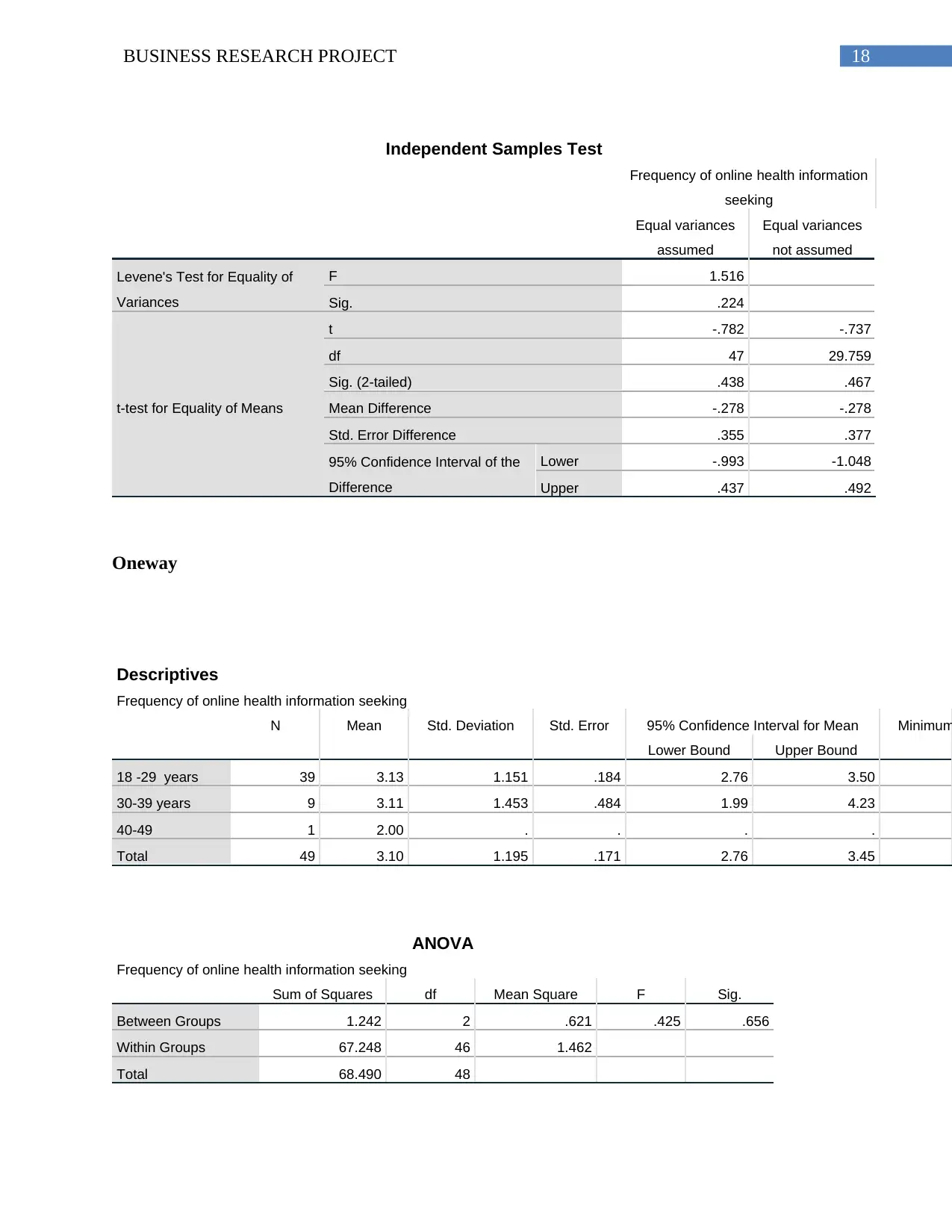
Independent Samples Test
Frequency of online health information
seeking
Equal variances
assumed
Equal variances
not assumed
Levene's Test for Equality of
Variances
F 1.516
Sig. .224
t-test for Equality of Means
t -.782 -.737
df 47 29.759
Sig. (2-tailed) .438 .467
Mean Difference -.278 -.278
Std. Error Difference .355 .377
95% Confidence Interval of the
Difference
Lower -.993 -1.048
Upper .437 .492
Oneway
Descriptives
Frequency of online health information seeking
N Mean Std. Deviation Std. Error 95% Confidence Interval for Mean Minimum
Lower Bound Upper Bound
18 -29 years 39 3.13 1.151 .184 2.76 3.50
30-39 years 9 3.11 1.453 .484 1.99 4.23
40-49 1 2.00 . . . .
Total 49 3.10 1.195 .171 2.76 3.45
ANOVA
Frequency of online health information seeking
Sum of Squares df Mean Square F Sig.
Between Groups 1.242 2 .621 .425 .656
Within Groups 67.248 46 1.462
Total 68.490 48
Paraphrase This Document
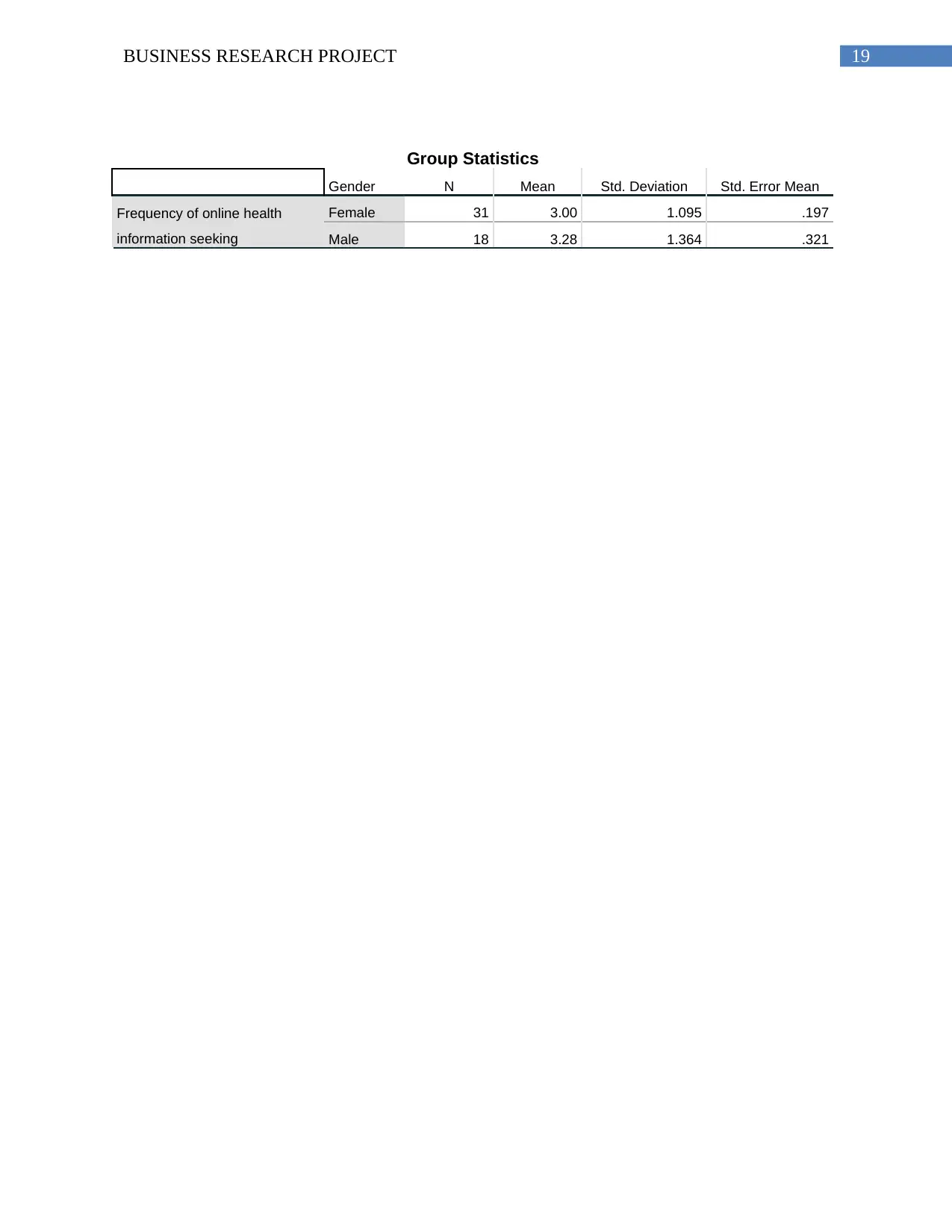
Group Statistics
Gender N Mean Std. Deviation Std. Error Mean
Frequency of online health
information seeking
Female 31 3.00 1.095 .197
Male 18 3.28 1.364 .321

Conclusion
The research has been seen to be related to the consideration of the several types of new
digital stages like “social media and online support groups”. These are conducive in terms of
allowing a growing number of people search for similar medical concerns. For example, there
are more than 26% of the internet users who have watched or read about the other’s experiences
for health and medical issues. The present research has identified the various types of the
concepts related to two main types of the health information, namely speciality-based
information considered by medical professionals and experience-based information based on
laypersons”. The various types of the depictions of the information as per comparing the “use
experience-based knowledge shared in social Internet sites, such as social media have been seen
with mostly positive results. In general, there has been large number of the depictions of the
results which are considered with the various types of the depositions of the results which are in
favour of the depictions of the information which are favoured to be positive for more
experienced users. The results interpreted as per the survey is further seen to be based on the
different types of the analysis of the information which is shown with the high amount of
responses which are in favour of the accessing of the blog information. Some of the different
types of the other information is analysed with the high amount of response for the support group
access.The consideration of the access of the information as per the professional help from the
health care professional has been seen to be based on the most responses in favour of often
option. In addition to this the results as per the results of the T-Test the equality of the variances
is seen to be depicted with .224. This shows that the there is a significant nature of the
relationship of gender and frequency of online health information seeking individuals. In
addition to this, the different types of the consideration of other information has shown that the
⊘ This is a preview!⊘
Do you want full access?
Subscribe today to unlock all pages.

Trusted by 1+ million students worldwide
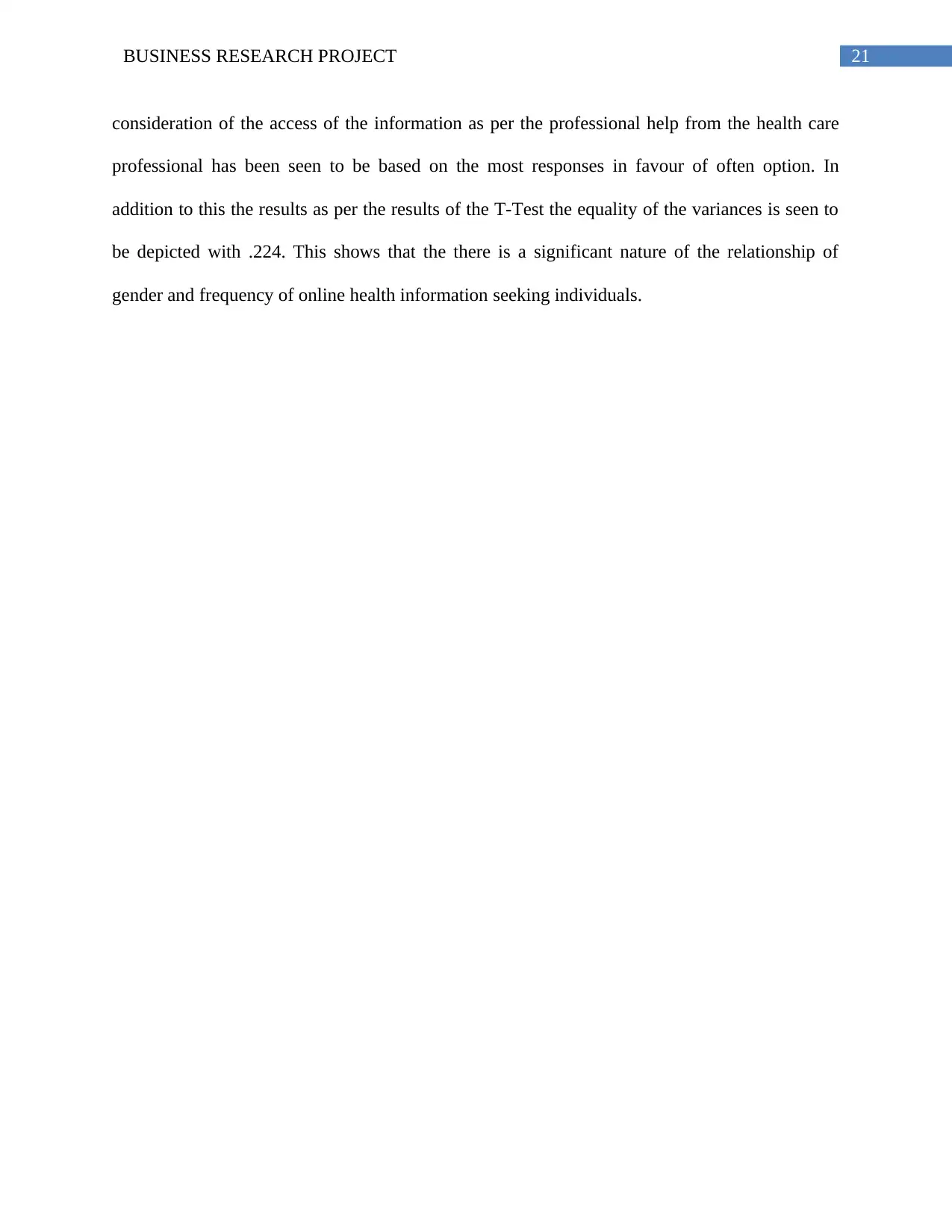
consideration of the access of the information as per the professional help from the health care
professional has been seen to be based on the most responses in favour of often option. In
addition to this the results as per the results of the T-Test the equality of the variances is seen to
be depicted with .224. This shows that the there is a significant nature of the relationship of
gender and frequency of online health information seeking individuals.
Paraphrase This Document
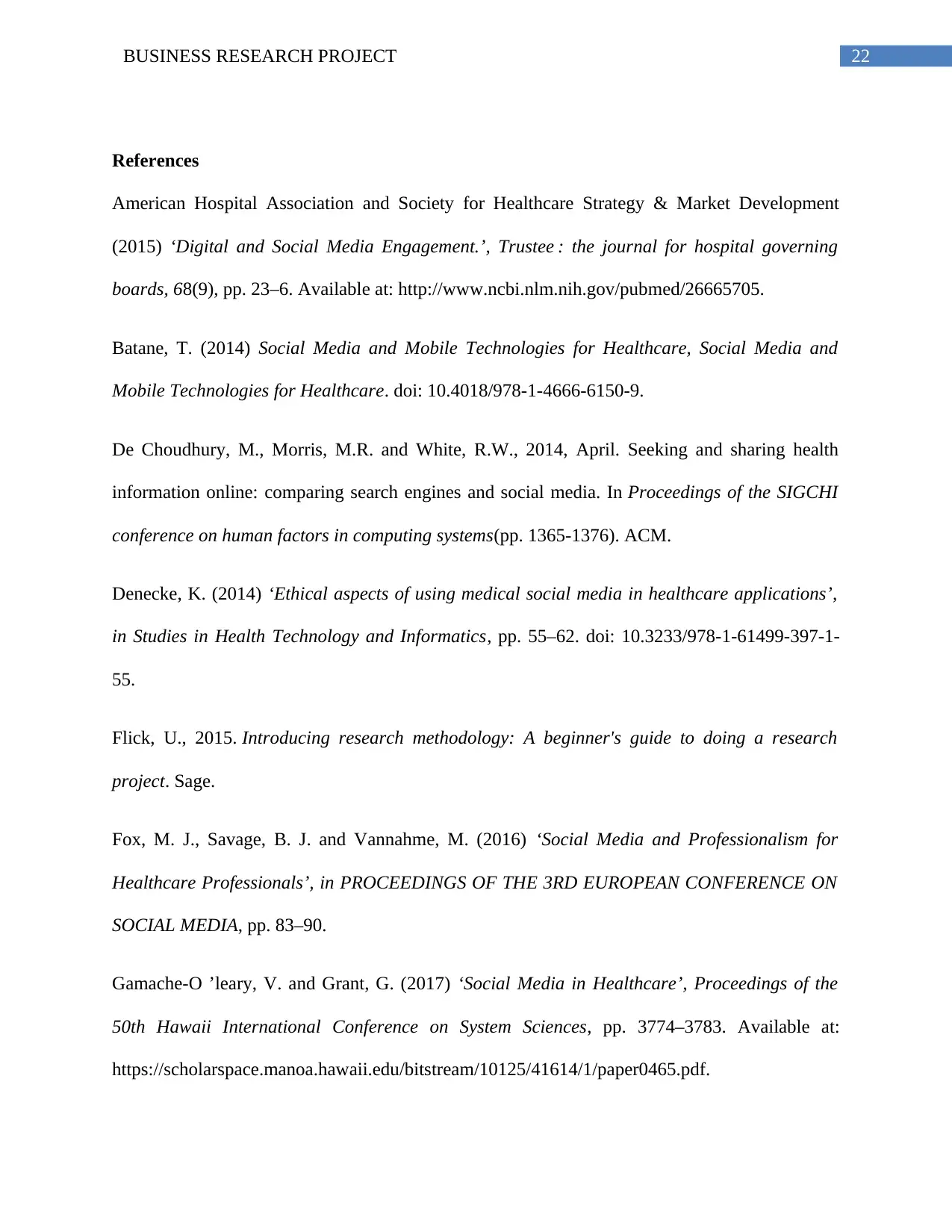
References
American Hospital Association and Society for Healthcare Strategy & Market Development
(2015) ‘Digital and Social Media Engagement.’, Trustee : the journal for hospital governing
boards, 68(9), pp. 23–6. Available at: http://www.ncbi.nlm.nih.gov/pubmed/26665705.
Batane, T. (2014) Social Media and Mobile Technologies for Healthcare, Social Media and
Mobile Technologies for Healthcare. doi: 10.4018/978-1-4666-6150-9.
De Choudhury, M., Morris, M.R. and White, R.W., 2014, April. Seeking and sharing health
information online: comparing search engines and social media. In Proceedings of the SIGCHI
conference on human factors in computing systems(pp. 1365-1376). ACM.
Denecke, K. (2014) ‘Ethical aspects of using medical social media in healthcare applications’,
in Studies in Health Technology and Informatics, pp. 55–62. doi: 10.3233/978-1-61499-397-1-
55.
Flick, U., 2015. Introducing research methodology: A beginner's guide to doing a research
project. Sage.
Fox, M. J., Savage, B. J. and Vannahme, M. (2016) ‘Social Media and Professionalism for
Healthcare Professionals’, in PROCEEDINGS OF THE 3RD EUROPEAN CONFERENCE ON
SOCIAL MEDIA, pp. 83–90.
Gamache-O ’leary, V. and Grant, G. (2017) ‘Social Media in Healthcare’, Proceedings of the
50th Hawaii International Conference on System Sciences, pp. 3774–3783. Available at:
https://scholarspace.manoa.hawaii.edu/bitstream/10125/41614/1/paper0465.pdf.

Humphries, B., 2017. Re-thinking social research: anti-discriminatory approaches in research
methodology. Taylor & Francis.
IMS Institute for Healthcare Informatics (2014) ‘Engaging patients through social media’, IMS
Institure for Healthcare Informatics, (January), pp. 1–47.
J., D., K., F., A., B., R., B., J., H. and I., S. (2017) ‘Social media etiquette among healthcare
professionals’, Obstetrics and Gynecology, 129, p. 76S. Available at:
http://www.embase.com/search/results?
subaction=viewrecord&from=export&id=L616800504%0Ahttp://sfx.library.uu.nl/utrecht?
sid=EMBASE&issn=15580474&id=doi:&atitle=Social+media+etiquette+among+healthcare+pr
ofessionals&stitle=Obstet.+Gynecol.&title=Obstetrics+a.
K, Denecke, P, Bamidis, C, B. (2015) ‘Ethical Guidelines for the Use of Social Media in
Healthcare Ethical Guidelines for the Use of Social Media in Healthcare’, Yearb Med Inform,
10(1), pp. 137–47.
Luo, J. S. and Smith, B. N. (2015a) ‘Social media.’, Mental health practice in a digital world: A
clinician’s guide., pp. 183–197. doi: 10.1007/978-3-319-14109-1_9.
Luo, J. S. and Smith, B. N. (2015b) ‘Social media’, Dewan, Naakesh A [Ed]; Luo, John S [Ed];
Lorenzi, Nancy M [Ed] (2015) Mental health practice in a digital world: A clinician’s guide (pp
183-197) xii, 228 pp Cham, Switzerland: Springer International Publishing; Switzerland, pp.
183–197. Available at: http://ovidsp.ovid.com/ovidweb.cgi?
T=JS&CSC=Y&NEWS=N&PAGE=fulltext&D=psyc11&AN=2015-14678-009%5Cn
⊘ This is a preview!⊘
Do you want full access?
Subscribe today to unlock all pages.

Trusted by 1+ million students worldwide
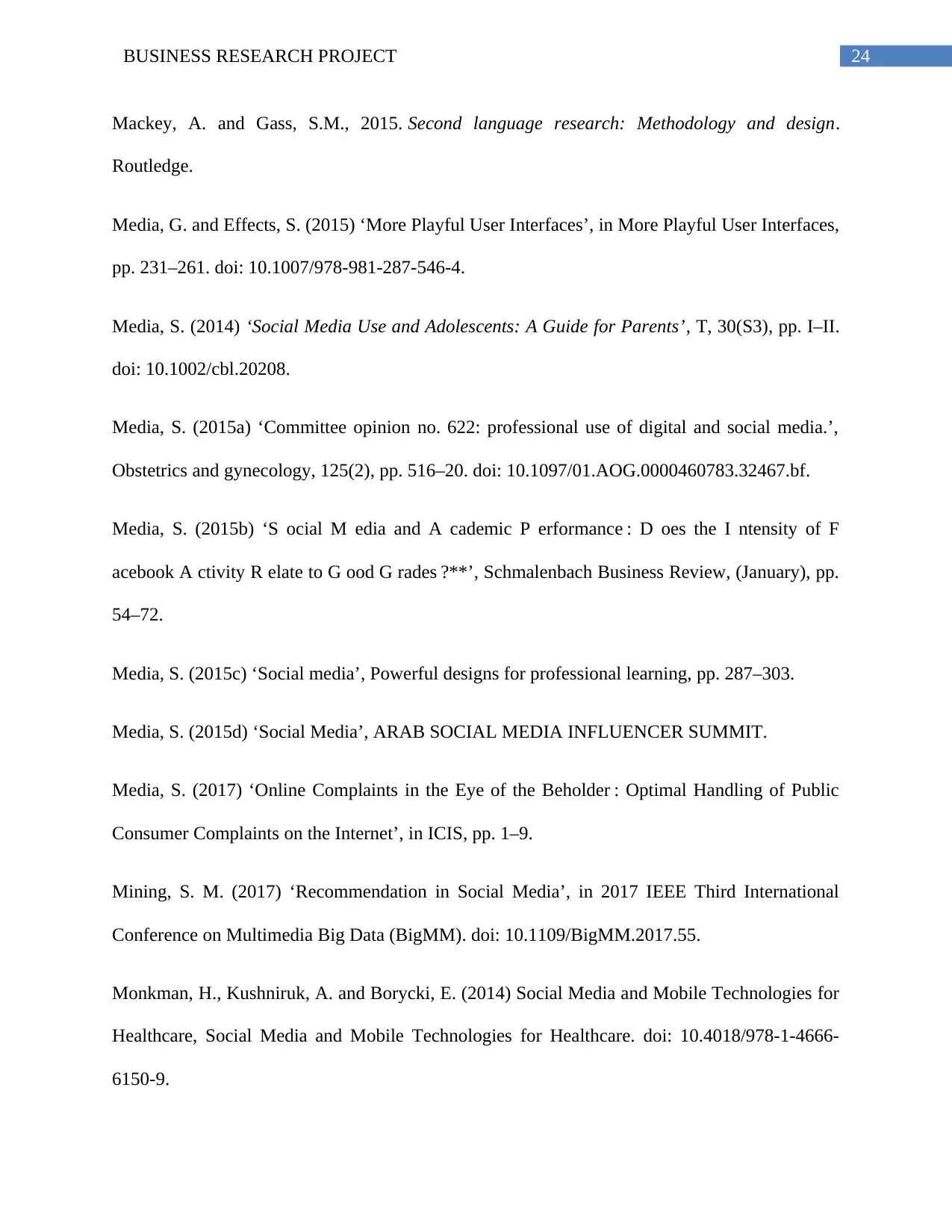
Mackey, A. and Gass, S.M., 2015. Second language research: Methodology and design.
Routledge.
Media, G. and Effects, S. (2015) ‘More Playful User Interfaces’, in More Playful User Interfaces,
pp. 231–261. doi: 10.1007/978-981-287-546-4.
Media, S. (2014) ‘Social Media Use and Adolescents: A Guide for Parents’, T, 30(S3), pp. I–II.
doi: 10.1002/cbl.20208.
Media, S. (2015a) ‘Committee opinion no. 622: professional use of digital and social media.’,
Obstetrics and gynecology, 125(2), pp. 516–20. doi: 10.1097/01.AOG.0000460783.32467.bf.
Media, S. (2015b) ‘S ocial M edia and A cademic P erformance : D oes the I ntensity of F
acebook A ctivity R elate to G ood G rades ?**’, Schmalenbach Business Review, (January), pp.
54–72.
Media, S. (2015c) ‘Social media’, Powerful designs for professional learning, pp. 287–303.
Media, S. (2015d) ‘Social Media’, ARAB SOCIAL MEDIA INFLUENCER SUMMIT.
Media, S. (2017) ‘Online Complaints in the Eye of the Beholder : Optimal Handling of Public
Consumer Complaints on the Internet’, in ICIS, pp. 1–9.
Mining, S. M. (2017) ‘Recommendation in Social Media’, in 2017 IEEE Third International
Conference on Multimedia Big Data (BigMM). doi: 10.1109/BigMM.2017.55.
Monkman, H., Kushniruk, A. and Borycki, E. (2014) Social Media and Mobile Technologies for
Healthcare, Social Media and Mobile Technologies for Healthcare. doi: 10.4018/978-1-4666-
6150-9.
Paraphrase This Document
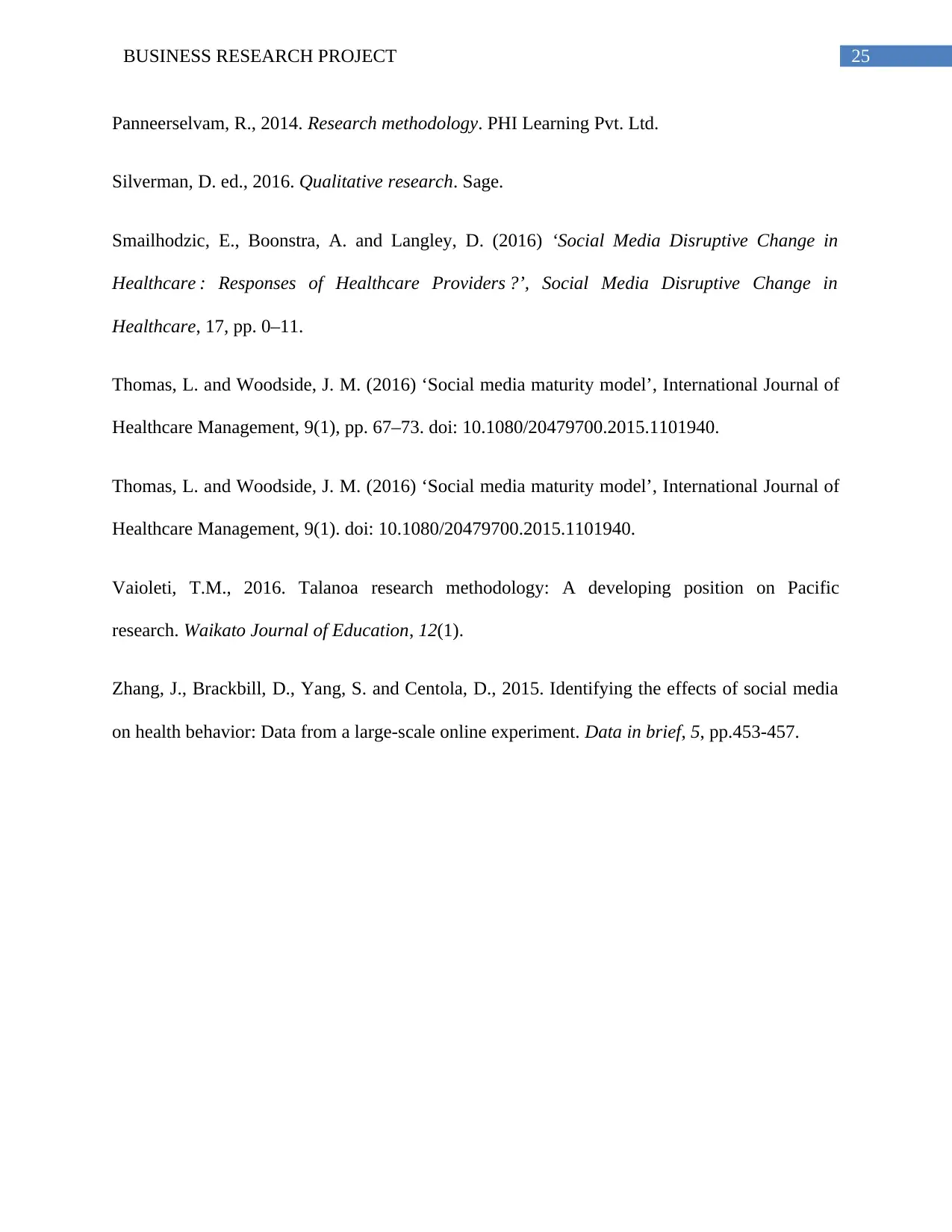
Panneerselvam, R., 2014. Research methodology. PHI Learning Pvt. Ltd.
Silverman, D. ed., 2016. Qualitative research. Sage.
Smailhodzic, E., Boonstra, A. and Langley, D. (2016) ‘Social Media Disruptive Change in
Healthcare : Responses of Healthcare Providers ?’, Social Media Disruptive Change in
Healthcare, 17, pp. 0–11.
Thomas, L. and Woodside, J. M. (2016) ‘Social media maturity model’, International Journal of
Healthcare Management, 9(1), pp. 67–73. doi: 10.1080/20479700.2015.1101940.
Thomas, L. and Woodside, J. M. (2016) ‘Social media maturity model’, International Journal of
Healthcare Management, 9(1). doi: 10.1080/20479700.2015.1101940.
Vaioleti, T.M., 2016. Talanoa research methodology: A developing position on Pacific
research. Waikato Journal of Education, 12(1).
Zhang, J., Brackbill, D., Yang, S. and Centola, D., 2015. Identifying the effects of social media
on health behavior: Data from a large-scale online experiment. Data in brief, 5, pp.453-457.
Related Documents
Your All-in-One AI-Powered Toolkit for Academic Success.
+13062052269
info@desklib.com
Available 24*7 on WhatsApp / Email
![[object Object]](/_next/static/media/star-bottom.7253800d.svg)
© 2024 | Zucol Services PVT LTD | All rights reserved.





